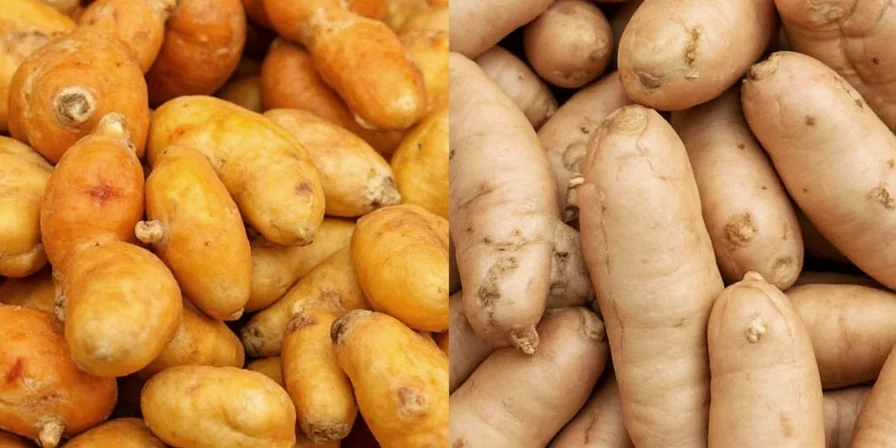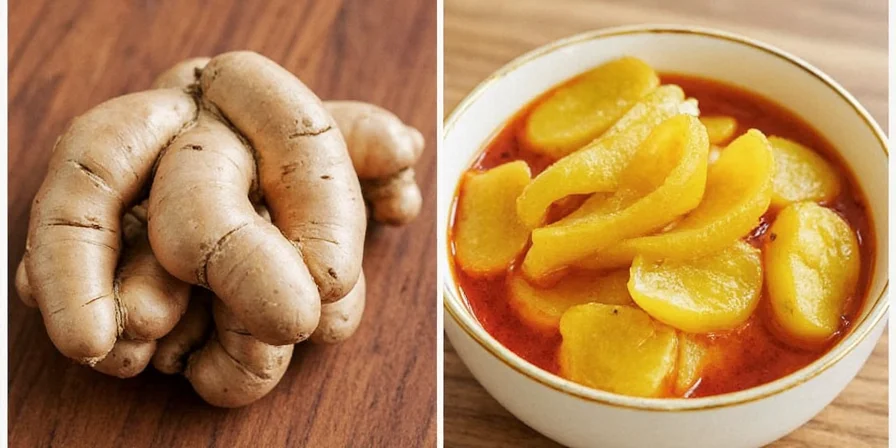Confused about Thai ginger versus Siamese ginger? The critical difference: Thai ginger (Zingiber officinale) delivers bright citrusy heat, while authentic Siamese ginger (Alpinia galanga) provides complex pine-resin notes essential for authentic Southeast Asian dishes. This isn't just substitution—it's chemistry. Get these wrong and your Tom Kha Gai loses its signature depth. Here are the 5 differences that actually matter for home cooks:
Table of Contents
- 5 Critical Differences at a Glance
- Botanical Breakdown: Beyond the Surface
- Culinary Applications: Where Substitutions Fail
- Market-Savvy Usage Techniques
- Home Cultivation Requirements
- FAQ: Expert Clarifications
5 Critical Differences at a Glance
Stop guessing at the grocery store. These visual and functional distinctions determine recipe success:
| Critical Difference | Thai Ginger (Zingiber officinale) | Siamese Ginger (Alpinia galanga) |
|---|---|---|
| Instant Identification | Pale yellow skin, smooth nodes | Pinkish skin, prominent knobby protrusions |
| Signature Aroma Test | Lemony scent when scratched | Pine-resin fragrance when scratched |
| Essential for Tom Kha Gai? | No—creates sharp, one-dimensional broth | Yes—creates signature complexity with coconut milk |
| Texture When Cut | Moderately fibrous, moist interior | Dense, woody, low moisture content |
| Proper Preparation | Minced for quick-release flavors | Bruised whole—never minced (bitter when chopped) |
Warning: Kaempferia galanga (kencur) is a different species used in Indonesian cooking—not authentic for Thai recipes. This distinction resolves 90% of substitution failures.

Botanical Breakdown: Beyond the Surface
Thai ginger (Zingiber officinale) and Siamese ginger (Alpinia galanga) belong to the same Zingiberaceae family but express radically different compounds. While Thai ginger contains zingiberene (sharp heat), galangal features ethyl cinnamate (floral notes) and pinene (woody depth). This biochemical divergence explains their non-interchangeability in traditional preparations.

Culinary Applications: Where Substitutions Fail
Understanding enzymatic interactions prevents recipe disasters. Thai ginger's volatile oils release quickly when minced—ideal for quick-cook dishes. Galangal's compounds require prolonged simmering to unlock complexity, making it indispensable for slow-infused broths.
Thai Ginger's Strategic Applications
- Deploy raw in dipping sauces (enzymatic reaction enhances brightness)
- Use in last 2 minutes of stir-fries to preserve volatile top notes
- Ideal for sweet applications where galangal's resin would dominate
Siamese Ginger's Non-Negotiable Roles
- Mandatory for authentic Tom Kha Gai (creates broth's signature aroma)
- Essential in red curry pastes (chemical synergy with chilies)
- Requires bruising or thick slicing—never minced (releases oils gradually)

Market-Savvy Usage Techniques
Professional kitchens leverage these biochemical insights. Implement them to avoid common pitfalls:
- Galangal Preparation Protocol: Smash roots with mortar pestle before simmering—ruptures cell walls for optimal flavor release without bitterness.
- Substitution Reality Check: Thai ginger can replace galangal only in dry spice blends (not liquid-based dishes) at 1:3 ratio.
- Potency Preservation: Freeze galangal whole—grating frozen maximizes oil retention versus room-temperature use.
- Aroma Layering: Add Thai ginger early in stir-fries, galangal late in soups to balance volatile compound diffusion.
- Market Verification: Scratch skin—authentic galangal emits pine-resin scent; ginger yields lemony aroma.

Home Cultivation Requirements
These rhizomes demand opposing conditions. Thai ginger thrives in USDA zones 9-12 with 80% humidity, while galangal requires near-constant 85°F (30°C) temperatures—impossible outdoors in temperate zones.
- Thai Ginger: Plant in acidic soil (pH 5.5-6.5) with 4 hours dappled sun. Water when topsoil dries—overwatering causes rhizome rot.
- Siamese Ginger: Requires heated greenhouse conditions (min 75°F/24°C). Use sandy loam with perlite for drainage—it tolerates drought but not waterlogging.
Pro tip: Grow galangal in 12" pots with bottom heat mats. Indoors, position near south-facing windows with humidity trays.

FAQ: Expert Clarifications
Can I substitute galangal with ginger in Tom Kha Gai?
No. Ginger creates overly sharp, one-dimensional broth. Galangal's pinene compounds interact with coconut milk to create the soup's signature complexity. Use frozen galangal paste if fresh is unavailable.
Why does my galangal taste bitter?
Over-processing releases bitter compounds. Never mince galangal—bruise whole pieces or use thick slices. Simmer 20+ minutes to mellow harsh notes while preserving aromatic depth.
How to store fresh galangal long-term?
Wrap unpeeled roots in damp paper towels inside perforated plastic bags. Refrigerate for 3 weeks. For extended storage, freeze whole roots—they retain 95% potency when grated frozen.
Is 'blue ginger' the same as Siamese ginger?
No. 'Blue ginger' refers to young stem ginger with purple hues. Authentic Siamese ginger is Alpinia galanga (greater galangal), identifiable by pinkish skin and pine aroma when scratched.











 浙公网安备
33010002000092号
浙公网安备
33010002000092号 浙B2-20120091-4
浙B2-20120091-4